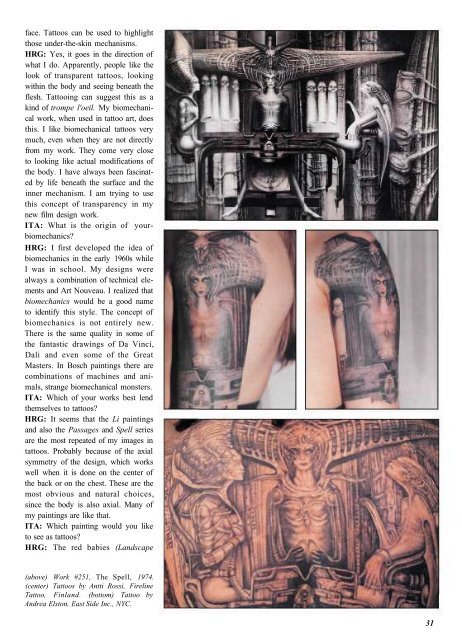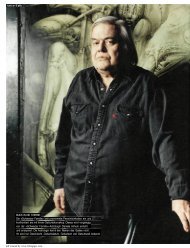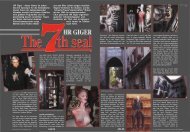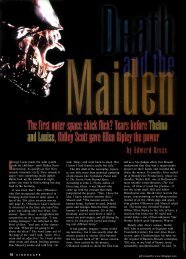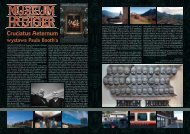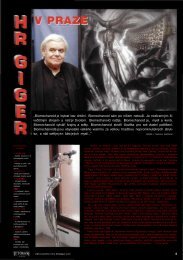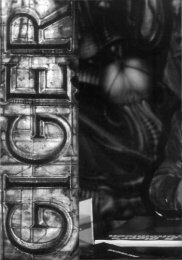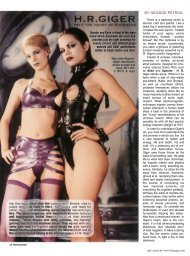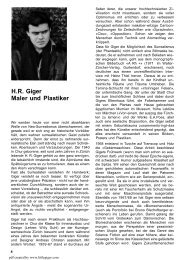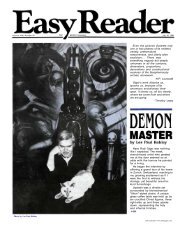You also want an ePaper? Increase the reach of your titles
YUMPU automatically turns print PDFs into web optimized ePapers that Google loves.
face. Tattoos can be used to highlight<br />
those under-<strong>the</strong>-skin mechanisms.<br />
HRG: Yes, it goes in <strong>the</strong> direction <strong>of</strong><br />
what I do. Apparently, people like <strong>the</strong><br />
look <strong>of</strong> transparent tattoos, looking<br />
within <strong>the</strong> body and seeing beneath <strong>the</strong><br />
flesh. Tattooing can suggest this as a<br />
kind <strong>of</strong> trompe l'oeil. My biomechanical<br />
work, when used in tattoo art, does<br />
this. I like biomechanical tattoos very<br />
much, even when <strong>the</strong>y are not directly<br />
from my work. They come very close<br />
to looking like actual modifications <strong>of</strong><br />
<strong>the</strong> body. I have always been fascinated<br />
by life beneath <strong>the</strong> surface and <strong>the</strong><br />
inner mechanism. I am trying to use<br />
this concept <strong>of</strong> transparency in my<br />
new film design work.<br />
ITA: What is <strong>the</strong> origin <strong>of</strong> yourbiomechanics?<br />
HRG: I first developed <strong>the</strong> idea <strong>of</strong><br />
biomechanics in <strong>the</strong> early 1960s while<br />
I was in school. My designs were<br />
always a combination <strong>of</strong> technical elements<br />
and Art Nouveau. I realized that<br />
biomechanics would be a good name<br />
to identify this style. The concept <strong>of</strong><br />
biomechanics is not entirely new.<br />
There is <strong>the</strong> same quality in some <strong>of</strong><br />
<strong>the</strong> fantastic drawings <strong>of</strong> Da Vinci,<br />
Dali and even some <strong>of</strong> <strong>the</strong> Great<br />
Masters. In Bosch paintings <strong>the</strong>re are<br />
combinations <strong>of</strong> machines and animals,<br />
strange biomechanical monsters.<br />
ITA: Which <strong>of</strong> your works best lend<br />
<strong>the</strong>mselves to tattoos?<br />
HRG: It seems that <strong>the</strong> Li paintings<br />
and also <strong>the</strong> Passages and Spell series<br />
are <strong>the</strong> most repeated <strong>of</strong> my images in<br />
tattoos. Probably because <strong>of</strong> <strong>the</strong> axial<br />
symmetry <strong>of</strong> <strong>the</strong> design, which works<br />
well when it is done on <strong>the</strong> center <strong>of</strong><br />
<strong>the</strong> back or on <strong>the</strong> chest. These are <strong>the</strong><br />
most obvious and natural choices,<br />
since <strong>the</strong> body is also axial. Many <strong>of</strong><br />
my paintings are like that.<br />
ITA: Which painting would you like<br />
to see as tattoos?<br />
HRG: The red babies (Landscape<br />
(above) Work #251, The Spell, 1974.<br />
(center) Tattoos by Antti Rossi, Fireline<br />
Tattoo, Finland. (bottom) Tattoo by<br />
Andrea Elston, East Side Inc., NYC.<br />
31


